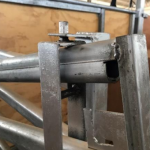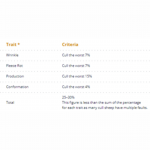- Quick picks – podcast, new coordinator, where to worm test, pain relief, shed stickybeak, resistant flies
- Deep dive – fly control
- Upcoming Leading Sheep events
- Podcasts, eBulletins and surveys
Quick picks
Our podcast is back online! We’ve released two new episodes – ramming right with Bim Goodrich and water monitoring with Andrew Barton – along with our past episodes. Download them for your next water run to hear what others are doing around Queensland.
 A new face has joined our team. We’re excited to introduce Belinda Rowbotham, our new regional coordinator for the North and Central West. With 35 years’ experience in the pastoral industry, Belinda has seen the wool crash, increased wild dog numbers and increasing awareness of the natural fibre. Belinda will work with familiar face Millie Sheales to run regionally relevant events, bringing together sheep and wool producers, experts and ideas to help you continue developing your business. Read more about Belinda here.
A new face has joined our team. We’re excited to introduce Belinda Rowbotham, our new regional coordinator for the North and Central West. With 35 years’ experience in the pastoral industry, Belinda has seen the wool crash, increased wild dog numbers and increasing awareness of the natural fibre. Belinda will work with familiar face Millie Sheales to run regionally relevant events, bringing together sheep and wool producers, experts and ideas to help you continue developing your business. Read more about Belinda here.
What about worms? If recent rain landed in your paddock, you can check out our new fact sheet on the different options for sending away or DIY worm egg counts. Worm burdens were likely low for most of Queensland, with prolonged dry conditions meaning larval burdens on pasture were also low. It’s a good idea to test 4 to 6 weeks after rain that has had follow up.
Where to buy pain relief. Did you know several pain relief options are now available over the counter? Local anaesthetic injections like Numnuts® (for castration and tail docking with rings) and oral formulations of meloxicam, Butec® and Buccalgesic®, that provide systemic pain relief, are available without a prescription. It might be worth a quick call to your vet to seek advice on which pain relief will work best for you and you should consider injectable formulations of meloxicam that still require a script.
 Shearing shed stickybeak. Check out the “Glenroy” shearing shed at Stonehenge. In this case study, Peter and Dianne Pidgeon take us for a look inside their shearing shed, including the new prefab plastic flooring, extended pens and changing the layout. To find out how much it cost, read the case study here. Hint: it was less than $10,000 and they get an extra 200 sheep through each day.
Shearing shed stickybeak. Check out the “Glenroy” shearing shed at Stonehenge. In this case study, Peter and Dianne Pidgeon take us for a look inside their shearing shed, including the new prefab plastic flooring, extended pens and changing the layout. To find out how much it cost, read the case study here. Hint: it was less than $10,000 and they get an extra 200 sheep through each day.
Are your flies resistant? Resistance to dicyclanil and cyromazine has been identified in Queensland. As part of an ongoing research program, you can find out if you have resistant flies on your place by sending in maggots. You will get a free report on the resistance profile of the flies affecting your sheep. It’s so easy! Have a collection kit on hand by phoning/emailing researcher Narelle Sales or drop in to see Millie or Sam at DAF’s Longreach or Charleville offices. Resistance could mean chemicals aren’t lasting quite as long as the label suggests, so check your active ingredients, keep a close eye on your sheep and be ready to re-treat sooner.
Managing Merino weaners. 10 questions and 2-3 minutes to contribute your strategies for managing weaners. The Managing Merino weaners to survive and thrive project is aiming to identify opportunities for cost-effective improvements in lifetime reproductive performance. Field work is underway in WA and NSW and the project is currently recruiting demonstration sites, but even just completing the survey will add valuable QLD data to the mix.
Deep dive – fly control
Project leader and vet Andrea McKenzie writes this month’s article on fly control.
Fly control may not be top of mind this Christmas, but save these links to check out after your roast lamb or lamb ham has digested.
A fly’s favourite weather is when the temperature is between 26 and 36oC (maggot development requires a temperature of 15oC), and wind is under 9km/hr. Add a bit of rain here and there and they’re in fly heaven.
 Obviously everyone’s calendar is different, so my first advice is to have a look at the FlyBoss Flystrike Risk Simulator. It works on historical weather data (not the current season) to compare and optimise treatment options for the ‘normal’ long-term weather patterns for your region. You can muck around with different timings for crutching and treatments to see the changes to relative risk of flystrike.
Obviously everyone’s calendar is different, so my first advice is to have a look at the FlyBoss Flystrike Risk Simulator. It works on historical weather data (not the current season) to compare and optimise treatment options for the ‘normal’ long-term weather patterns for your region. You can muck around with different timings for crutching and treatments to see the changes to relative risk of flystrike.
Double check you are rotating chemicals. My favourite ParaBoss tool is the Product Search Tool. You can search by parasite/host, chemical, product name, application method, protection length and more. It’s such a time saver and no more mixing up brands and actives! If you’re applying chemical multiple times throughout a fly season, swap chemical groups. This is harder between fly seasons because dicyclanil is the only chemical that provides very long protection, but keep it in mind if your fly risk period is shorter.
It’s also important to monitor the ‘tail’ of the protection period. This is when the chemical concentration has dropped to a level where maggots of resistant flies can survive, acting like a drafting gate for resistant maggots. Reduce the tail by shearing/crutching before the tail period, choosing a product that lasts longer than your risk period, or applying another effective preventative chemical form a different chemical group before the tail period. Ideally, having minimal tail periods (i.e. separate treatments applied) in a season is the best way to reduce tail periods. Keep in mind your lice treatment may be contributing to resistant flies too.
Here are a few other things you can consider to reduce the susceptibility of your flock:
- Tail docking length – the recommended length is immediately below the third palpable joint. It allows the sheep to lift its tail and channel urine and faeces away from the breech area but is long enough to reduce the risk of skin cancers and prolapse.
- Culling strategy for sheep that have been struck – sheep that have been struck are likely to be struck again. If possible, identify sheep when you treat them and consider them in your next cull. The visual scores guide might help decide which to cull if you’re getting too many struck sheep to cull all of them.
 Breeding objectives for flystrike susceptibility – reducing the incidence of any type of strike will reduce your overall flystrike risk because less strike means less fly reproduction. Using ASBVs for wrinkle and breech cover, balanced with your performance traits (e.g. fleece weight and fibre diameter) is preferable, but if no ASBVs are available, breech or body wrinkle scores assessed off shears might be available. This article is worth a read if you want tips on how to incorporate flystrike risk into your existing breeding strategy.
Breeding objectives for flystrike susceptibility – reducing the incidence of any type of strike will reduce your overall flystrike risk because less strike means less fly reproduction. Using ASBVs for wrinkle and breech cover, balanced with your performance traits (e.g. fleece weight and fibre diameter) is preferable, but if no ASBVs are available, breech or body wrinkle scores assessed off shears might be available. This article is worth a read if you want tips on how to incorporate flystrike risk into your existing breeding strategy.
These aren’t huge revelations in the fly space, but hopefully some of these tools can help you fine-tune and reduce the impact of flies on your flock this fly season.
Upcoming Leading Sheep events
- Have you got an idea for a workshop or webinar? Our regional producer committees want your ideas. The committees will be meeting in about February, so find your local coordinator or a committee member (chances are you’ll know one!) and let them know. Or simply hit reply to this email. We hope to see you next year!
- Since your calendar will be full of Christmas catch ups, you might find some delicious lamb recipes to take along.
Podcasts, eBulletins and surveys
- Around the Camp Leading Sheep podcast
- AuctionsPlus Sheep Results and Catalogue
- AWI Beyond the Bale magazine
- AWI The Yarn podcast
- AWI Weekly Wool Market Report
- Farm Biosecurity News
- MLA Prices and Markets
- Sheep Producers Australia News
- Wool Producers Australia News
